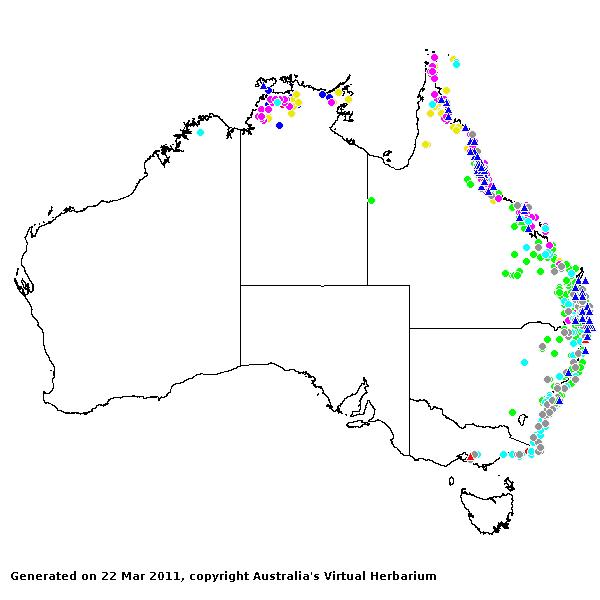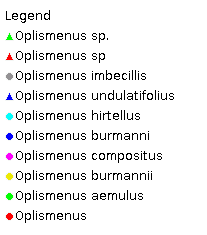Oplismenus Fl. Oware 2: 14 (1810).
Derivation:. From Greek hoplismenus (armed), alluding to the armour (?awns) of the spikelets.
Taxonomic revisions, nomenclatural references:. U.Scholz, Monograph. Oplismenus. Vaduz: J.Cramer (1981).
Key references (keys and floras):. G.Bentham, Flora Australiensis 7: 491–492 (1878); E.E.Henty, Manual Grasses New Guinea 132–133 (1969); J.W.Vickery, Flora of New South Wales, Gramineae 19: 215–219 (1975); M.Lazarides, Tropical Grasses S.E. Asia 124–125 (1980); J.C.Tothill and J.B.Hacker, Grasses of Southern Queensland 316–317 (1983); R.D.Webster, Australian Paniceae 111–116 (1987); B.K.Simon, Key to Australian Grasses 134 (1993); S.W.L.Jacobs and S.M.Hastings, Flora of New South Wales 4: 490–492 (1993); N.G.Walsh, Flora of Victoria 2: 584 (1994); E.Edgar and H.E.Connor, Flora of New Zealand 5: 552–553 (2000); D.Sharp and B.K.Simon, AusGrass (2002); S.W.L.Jacobs, R.D.B.Whalley & D.J.B.Wheeler, Grasses of New South Wales, 4th ed, 308–309 (2008).
W.D.Clayton & S.A.Renvoize, Genera Graminum (1986), genus (451).
Native. 9 species, from tropical and subtropical regions. 5 species in Australia, WA, NT, Qld, NSW, and Vic. Also New Guinea, Malesia and New Zealand.
Habit. Annual or perennial, decumbent. Leaf blades broad or narrow. Ligule a fringed membrane (very short) or a fringe of hairs.
Inflorescence. Inflorescence of spicate main branches (short unilateral racemes along a central axis), a racemose panicle with spikelets all similar, open.
Spikelets. Spikelets 2 flowered, with 1 fertile floret, awned, solitary or paired (or the lower member reduced, or in clusters), shortly pedicelled. Fertile spikelets with lower incomplete floret(s), elliptic or lanceolate or ovate, abaxial (with lower glume on side away from rachis) (borne on one side of branch), weakly laterally compressed or subterete to dorsally compressed, falling with glumes.
Glumes. Glumes more or less equal, shorter than adjacent lemmas or long relative to adjacent lemmas, awned (both or at least the lower, the awn of the lower always longer), keeled, similar (herbaceous, the awns often viscid). Lower glume 3–5 nerved. Upper glume 5 nerved.
Florets. Lower incomplete floret(s) male, or sterile. Lemmas shortly awned or awnless, 5–9 nerved, not becoming indurated. Fertile florets 1. Lemmas dorsally compressed, similar in texture to glumes to decidedly firmer than glumes (papery to leathery), smooth (glossy), becoming indurated to not becoming indurated, white in fruit or yellow in fruit, entire at apex, indistinctly crested at tip or not crested, muticous, with a clear germination flap, 3–5 nerved, glabrous, having margins tucked into palea, 1 keeled to not keeled. Palea relatively long, entire (acute), textured like lemma (smooth, glossy), indurated or not indurated, 2 nerved. Lodicules 2. Stamens 3. Grain ellipsoid, longitudinally grooved (slightly) or not grooved, compressed dorsiventrally. Hilum short to long-linear (oblong, up to a half as long as the fruit). Embryo large.
Kranz Anatomy. C3.
2n = 18, 36, 54, 72, and 90.
Habitat. Mesophytic. In forest. Shade species.
Classification. Panicoideae; Paniceae.
Notes. A genus of very closely related species. The sticky secretion on the awns is an unusual means of fruit dispersal in the grasses (Clayton and Renvoize, 1986).
Types Species. O. africanus P.Beauv.
Biogeographic Element. Clifford & Simon 1981, Simon & Jacobs 1990: Gondwanan.


